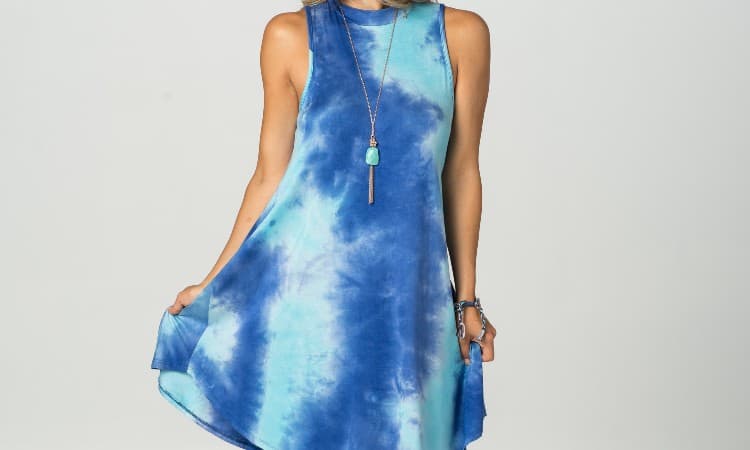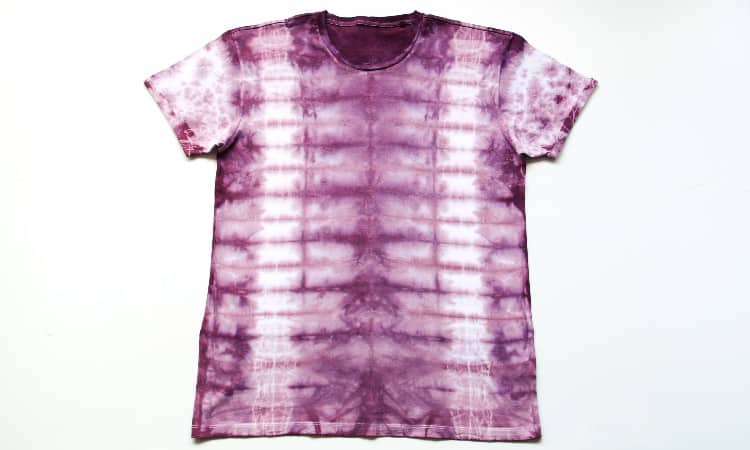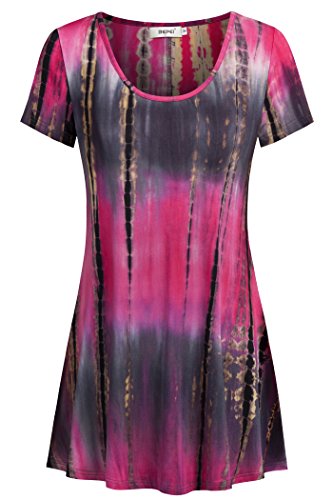Tie-dyeing is a great way to give old clothing a boost. It’s a fashion statement and a cool way to personalize garments. I’m thinking of trying it on one of my shirts. My only dilemma is, it’s made out of rayon. Can you tie-dye rayon?
Yes, you can tie-dye rayon. As a semi-synthetic fabric, rayon is super absorbent. This makes it a great candidate for dyeing. Fiber reactive dyes are the best option for rayon as the color will last longer. However, you can also use an all-purpose dye or dyes suitable for natural fibers like cotton.
In this article, we’ll discuss if you can tie-dye rayon and look at the different types of dye you can use. Plus, we’ll give you all the tips and tricks on how to tie-dye rayon fabric for best results.

Can You Dye Rayon?
Rayon is a semi-synthetic fabric made from processed wood pulp. It’s also known as viscose. To make the wood pulp soft enough for clothes, chemicals are added during the production process. Because of this, rayon isn’t classed as a natural fiber.
It’s a hybrid. Normally, when you mix a natural fiber with synthetics, you get a fabric that benefits from the advantages of both. That’s not the case with 100% Rayon. Although it contains man-made elements, its natural side shines through. Making those characteristics dominant. This is great news if you want to dye your rayon blouse a different color.
Rayon’s natural wood base gives it an amazing talent. The fabric is super-absorbent and will soak up moisture like a sponge, dragging it into the fibers. As dyes are liquid-based, their color will spread throughout the material from top to bottom, resulting in a deep, vibrant shade.
Due to being a mix of natural and synthetic, you can use any dye on Rayon. Although you may find you get a better result with reactive dyes.
There is one type of rayon fabric that can be problematic. If your rayon is a blended fabric and contains 50% or more polyester, the overall dye effect will be blotchy or uneven. There is a distinct possibility the fabric won’t take to the dye at all.
Synthetic fibers, particularly polyester, are notoriously difficult to dye, so you need to use heat which is bad for both the polyester content and the rayon.
Before you attempt to dye your rayon, check the garment label for fiber content. You need the natural fiber content to be higher than 50% for any dyeing process to succeed. A 50/50 rayon and cotton blend will work brilliantly. If you have a 50/50 rayon-polyester blend, you are going to have issues trying to dye it.
Can You Tie Dye Rayon?
 Yes, you can tie-dye rayon. However, as rayon can be easily damaged when it’s wet, it isn’t the best fabric to use for this style of dyeing. To find out why we need to look at what tie-dyeing entails.
Yes, you can tie-dye rayon. However, as rayon can be easily damaged when it’s wet, it isn’t the best fabric to use for this style of dyeing. To find out why we need to look at what tie-dyeing entails.
Tie-dyeing is a technique where a garment is twisted into coils or tied into knots before being dyed. The dye only comes into contact with the visible portions of the fabric. Material inside the ties or twisted sections remains unchanged. This can create unique patterns or an all-over mottled effect.
Rayon is incredibly simple to dye because of its ability to absorb water. However, this superpower is also its biggest disadvantage. The fabric is at its weakest when it’s wet and can tear easily.
As tie-dyeing involves twisting the material into knots or coils, the risk of accidentally ripping the fabric increases with every kink, twirl, or spiral you make. Particularly if you use elastic bands to hold the twists in place.
Matching a rayon fabric with the tie-dye method is possible, but you must be extra cautious. Handle the material with care and keep the twists and turns to a minimum.
What Is the Best Dye for Rayon Fabric?
You can dye rayon with any fabric dye suitable for use on natural fibers like cotton. Rayon, also known as rayon viscose, is made from chemically processed wood pulp, which means it’s plant-based, just like cotton and linen.
When it comes to dyes, there are several different options. Let’s take a look at the various dyes you’ll come across in your search for the best dye for rayon fabric.
Reactive Dyes
 A fiber reactive dye has been specially formulated to work with cellulose-based fabrics. You can find cellulose fibers in cotton and rayon. So you should make this dye your first choice for dyeing rayon fabric. It will give you the best results.
A fiber reactive dye has been specially formulated to work with cellulose-based fabrics. You can find cellulose fibers in cotton and rayon. So you should make this dye your first choice for dyeing rayon fabric. It will give you the best results.
Not only that, but reactive fiber dyes work in cold water, which is perfect for rayon. As rayon fibers are natural, they tend to shrink in hot water.
Fiber reactive dyes give bright, long-lasting color and are a lot easier to apply than their all-purpose cousins. The reason is the dye forms a bond with the fiber. So instead of coating the surface, the color becomes a part of the fiber structure.
The best reactive dye for tie-dyeing is known as a Procion MX dye. Procion MX used to be the patented brand name, but as the patent has expired, you can now get similar generic dyes. This is the type of dye found in tie-dye kits sold at craft stores. It is by far the easiest one to use for beginners.
All-Purpose Dyes
 As the name suggests, an all-purpose dye is suitable for use on natural fibers like cotton and wool. It can also be used on nylon and rayon. It’s a bit like a one-size-fits-all dye in that it will cover any fabric, just not particularly well.
All-purpose dyes are hot-water dyes and made from a mix of an acid dye and a direct dye. Because it contains both types, it’s a good dye to use on fabric blends. So if you have a rayon mixed with nylon, this could be the best solution for tie-dyeing your garment.
As the name suggests, an all-purpose dye is suitable for use on natural fibers like cotton and wool. It can also be used on nylon and rayon. It’s a bit like a one-size-fits-all dye in that it will cover any fabric, just not particularly well.
All-purpose dyes are hot-water dyes and made from a mix of an acid dye and a direct dye. Because it contains both types, it’s a good dye to use on fabric blends. So if you have a rayon mixed with nylon, this could be the best solution for tie-dyeing your garment.
However, all-purpose dyes do have a couple of disadvantages. The color isn’t long-lasting and can wash out with every trip to the laundry. Worse than that, the shade will bleed into the water as the garment is being washed. Meaning, you will have to wash your tie-dyed rayon shirt on its own.
The need to use hot water is also problematic. Depending on the fiber content you are working with, the heat from the water could cause shrinkage for rayon. Any synthetic content could melt.
Natural Dyes
Natural dyes have been around for millennia. They are made from various plants, such as birch bark, barberry root, club moss, and even chalk.
Dyeing your clothing with a natural product is appealing from an ecological point of view. But, it’s not without its own risks and isn’t as reliable as commercially prepared products.
These dyes can have limited success on cellulose-based fibers. Although it’s possible to use them with fabrics like rayon, they don’t provide long-lasting color and are difficult to use. You may find the color fades alarmingly quickly, ruining your tie-dye project.
You will also struggle to dye rayon successfully if it contains any synthetic fiber. Natural dyes won’t work on any artificial material. If your rayon blouse has a polyester thread, this could lead to blotches and missed areas.
More concerning is the process of dyeing your clothing with a natural dye. Some require the use of mordants to enable them to adhere to the fibers in a fabric. As many mordants are heavy metal ions, they can be toxic. Copper, iron, and alum are all popular mordants with varying degrees of toxicity.
With all dyes, it’s important to follow the directions on the product packaging. This will help you achieve the best results from the dye you choose. It will also ensure you can dye your rayon safely and effectively.
How to Tie Dye Rayon

The following step-by-step guide is an overview of getting the best results when you tie-dye rayon fabric. Whatever dye you choose, always remember to read the instructions on the product packaging before you start the dyeing process.
You will need:
- Fabric dye – Fiber reactive or all-purpose
- Rubber gloves
- 2 large buckets
- Soda ash & warm water soak
- Hot or cold water
- Elastic bands
- Ziplock bag
Step 1
Before you dye your rayon clothing, make sure it is completely clean by pre-washing it in warm water with a mild, unscented detergent. Don’t apply any fabric softener. Leave the garment to air dry.
Step 2
In your first bucket, prepare a soda ash soak. Soda ash is another name for sodium carbonate and can be purchased from your local retail store or supermarket. Mix 1 cup of soda ash per 1 gallon of warm water. The mixture needs to completely cover your garment.
Leave your clothing to soak for a minimum of 20 minutes. There is no maximum time limit. You can leave it as long as you like, even overnight. Wearing your rubber gloves, gently swirl the garment around occasionally as it soaks. The soda ash soak will help ensure your dyed garment will be colorfast and vibrant.
Step 3
Remove the garment from the bucket and expel as much water as you can. As you are working with rayon, be extra careful if you wring the clothing. Wringing or twisting rayon when it is wet can tear the fabric.
Instead, try pushing the garment against the wall of the bucket and allow the water to drain out of the fabric. Try to remove as much water as possible as a damp garment will dye better than a soaking wet one.
Step 4
Once you are happy you have taken out as much water as possible, start to shape your garment for tie-dyeing. You can twist it into a spiral, fold it into a concertina shape, or tie loose knots into it.
Secure the folds or twists with elastic bands. Be mindful of the location of your bands, as these will also stop the dye from reaching the fabric.
Step 5
Follow the manufacturer’s instructions for mixing the dye with water. If you still have your soda soak in one bucket, use your second bucket. Make sure the dye is fully dissolved before adding your garment. Remember to use cold or warm water for rayon.
Step 6
Submerge your garment in the dye and allow it to sit. How long you leave it depends on the depth of color you are looking for. For a lighter shade, remove after 5-10 minutes and place the wet garment in a ziplock bag.
Leave the bagged garment for at least 24 hours so it can cure or set. Make sure to seal the bag so that the moisture and dye stay in the bag with the garment.
Step 7
When the 24 hours are up, remove your rayon garment from the bag. With extreme care, remove the elastic bands. Rayon is very delicate when it’s wet so go slowly with this stage.
Rinse with cold water until the water runs clear. You should be able to see the results of your tie-dyeing. Wash your newly dyed rayon by hand in warm water. Use a small amount of dish soap to remove all the excess dye. Then rinse again until no more color shows in the water.
Step 8
Launder the garment as you would normally. In case there is any residual dye left over, wash separately from other clothing. Dry as normal in your dryer or allow to air dry. Once it’s dry, your tie-dyed rayon garment will be ready to wear.
How Do You Set the Dye in Rayon?
There are a couple of ways to set the dye in rayon fabric. Let’s take a look at each one so you can identify which one will work best for you.
Cold or Warm Water Rinse
You can rinse the fabric in either cold or warm water. If you used a light-colored dye, use a cold rinse.
A darker color will need a warm water rinse. The difference in temperature is due to dark colors using more dye. Warm water will work to remove any excess dye quicker and set the remaining color faster.
Once the color has stopped running from both light and darker colors, do a final rinse in cold water to make sure all the excess dye has been removed.
Salt and Vinegar Soak
Another method for setting the dye in rayon is to use salt and vinegar. As well as working when the tie-dyed garment is fresh from the dyeing pot, you can also use this method on dry clothing.
Simply fill a bucket with clean water and add 1/4 cup of table salt and 1 cup of vinegar. Swish it around to mix everything. Then add your garment and make sure it is completely soaked with the mixture. Leave it in the bucket for 24 hours.
Remove the garment and change the water. If any color has leaked out of the rayon garment, repeat the salt and vinegar soak. Once the water stays clear, you can let your clothing dry out naturally. Next time you launder it, the rayon will be colorfast.
Can You Tie Dye a Rayon Spandex Blend?
 You can tie-dye a rayon-spandex blend. However, you might not end up with the effect you were hoping for. You’ll also be restricted to the type of dye you can use.
You can tie-dye a rayon-spandex blend. However, you might not end up with the effect you were hoping for. You’ll also be restricted to the type of dye you can use.
Avoid using any heat with spandex as it will ruin the stretchiness of the material. This means the only dye you can use is one suitable for use in cold water.
A reactive fiber dye known as Procion MX is not only the best dye option for tie-dyeing rayon, it’s also safe for spandex. However, as spandex doesn’t dye that well, you may find the finished garment has areas that didn’t take to the dye. Stitching lines are particularly difficult to dye with synthetic materials.
Can You Tie Dye Rayon With Tea or Coffee?
 Yes, you can tie-dye rayon with tea and coffee. However, it may not be easy to gauge what shade of color or effect you will end up with.
Yes, you can tie-dye rayon with tea and coffee. However, it may not be easy to gauge what shade of color or effect you will end up with.
For both tea and coffee, the final shade will be determined by the strength of the brew. For darker shades, you’ll need a strong pot of coffee, or if you’re using tea, 40 teabags.
Pre-soak your rayon in a soda ash bath to ensure the rayon fibers absorb the tea and coffee. Then, simply prepare your garment by twisting it and securing it with elastic bands.
Submerge the rayon in a bucket filled with either tea or coffee.
The longer you leave it to soak, the darker the color will be. Be prepared for the effects to be short-lived, though. The biggest drawback with tea and coffee is that neither will last very long. Over time, the color will fade.
Can You Bleach Tie Dye Rayon?
Although you can bleach tie-dye rayon, it isn’t recommended. Rayon can be a delicate fabric and needs a careful hand, especially when it’s wet.
Bleaching a fabric to create a tie-dye effect involves stripping the color out of the fibers. The main issue here, the rayon will be soaked and bleach is a harsh chemical. Any kind of rough treatment is going to reduce wet rayon to shreds.
If you are sure a bleached garment is a look you want, practice on an old rayon garment first. That way, you can check out how the method will alter the fabric without destroying the clothing you want to bleach.
Conclusion
Tie-dyeing rayon is a lot easier than you think. Especially if you are working with a 100% rayon fabric. Follow our hints and tips and you’ll find you can tie-dye rayon easily at home.
I hope you liked the article. Has it inspired you to tie-dye rayon? Have you already tried to tie-dye your own clothes at home? Let me know in the comments.